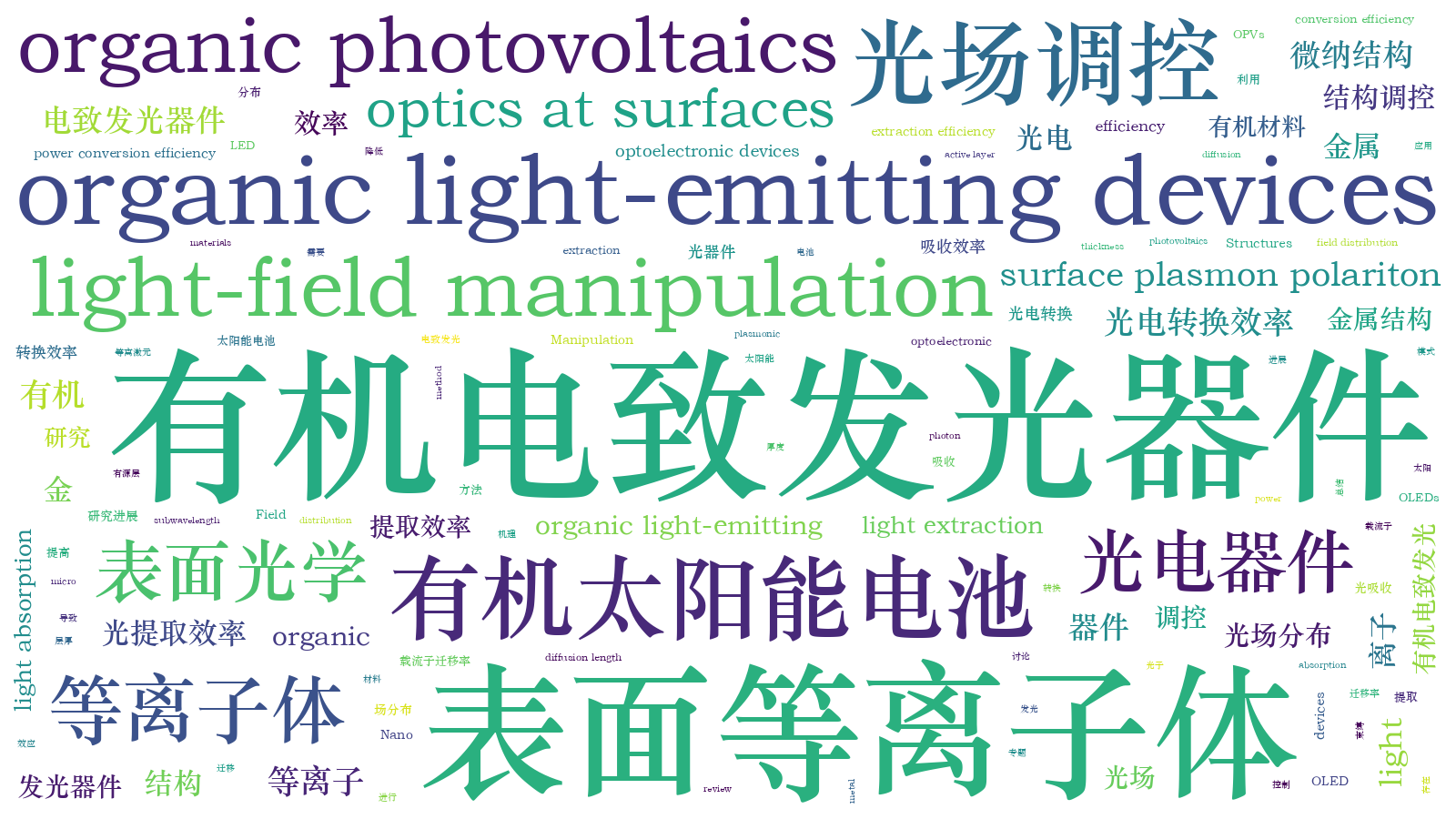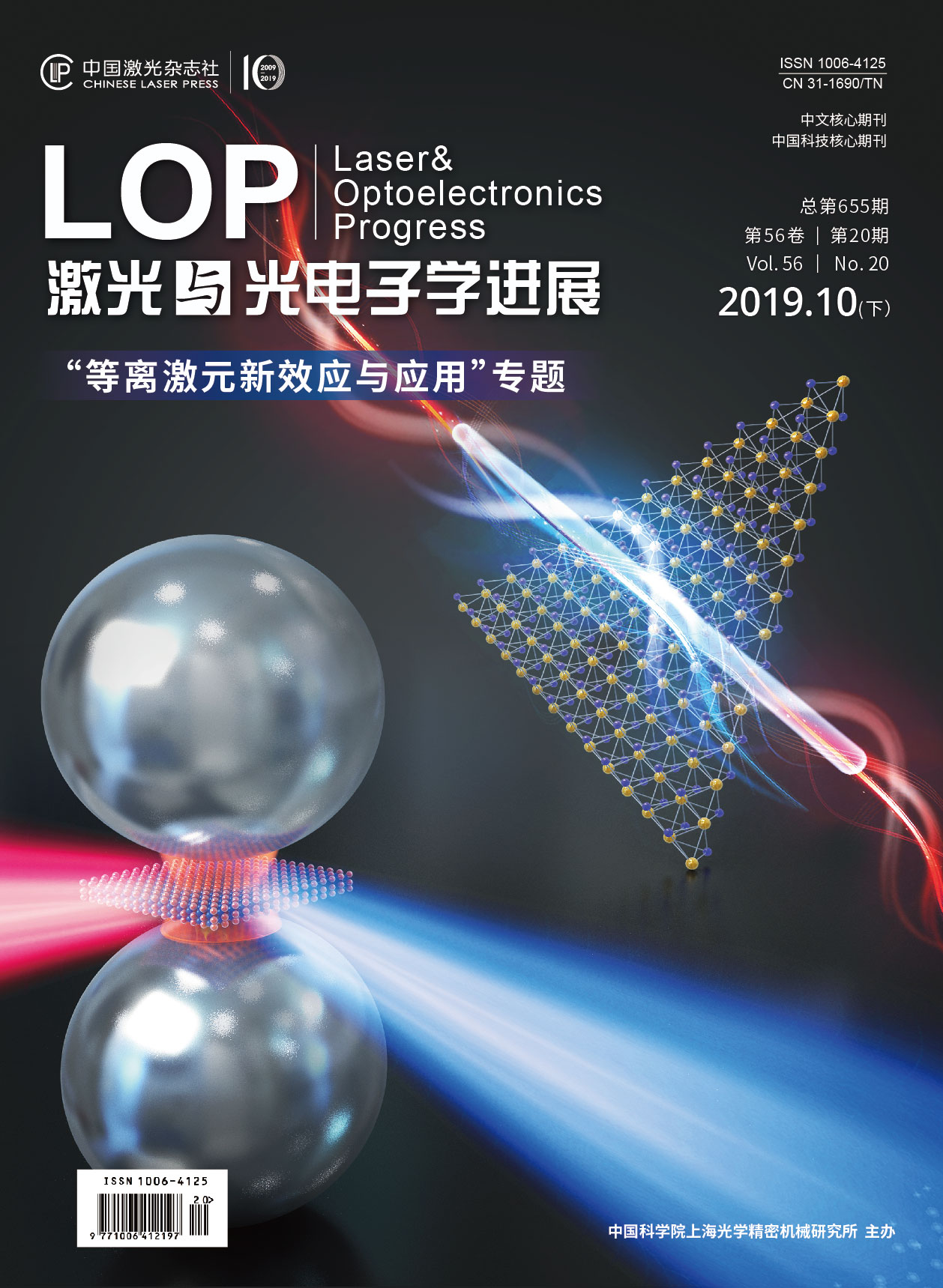金属等离子体微纳结构对有机光电器件光场调控的研究  下载: 2228次特邀综述
下载: 2228次特邀综述
1 引言
以有机半导体材料为基础的有机光电器件,具有功耗低、成本低、工艺简单、可大面积制造、有机分子的结构和性能可剪裁、材料无毒等优势,在性能和应用上可以与无机半导体光电器件形成互补,从而在市场上占据不可替代的位置。有机薄膜自身因具有优异的柔性,及能制备在轻薄的柔性衬底上,可以满足现代电子产品的发展需要,能应用于可折叠卷曲的柔性便携式电子产品中。目前有机光电器件已经在显示、照明、太阳能电池、传感、生物医学等多个领域展现出应用潜力。
有机电致发光器件(OLEDs)是以有机半导体材料作为活性层,在电场的作用下,发生光辐射的器件[1]。OLEDs通常由电子/空穴注入层、电子/空穴传输层、发光层、透明电极和反射电极组成,其电致发光过程大致可分为4个阶段:电子和空穴从电极注入到有机功能层;在电场的作用下,注入的电子和空穴在有机功能层中传输;电子和空穴形成激子;激子发生辐射跃迁产生光子。在OLEDs中,激子复合产生的光子,会有很大一部分被束缚到波导模式(由于透明电极铟锡氧化物(ITO)层的折射率较高,光子在ITO层和衬底界面会发生全反射而被束缚到ITO层和各种有机功能层中),衬底模式(光子在玻璃衬底和空气界面发生全反射,使得一部分光被限制在玻璃衬底内部)和表面等离子体模式(存在于金属电极和有机材料界面的非辐射模式)中,由于这些非辐射模式的存在,OLEDs的光提取效率不足20%[2-3]。通过在玻璃衬底背面引入修饰层,例如微透阵列或者光提取薄膜,可以取出被束缚在衬底模式中的光子[4-10]。利用高折射率材料作为衬底[11-13],以及在衬底中引入高折射率的散射粒子[14-16],可以抑制波导模式。在金属电极和有机材料界面引入亚波长微纳结构,激发表面等离子体模式耦合出射,是减少因表面等离子体模式导致的器件能量损失的有效途径[17-24]。
有机太阳能电池(OPVs),是将光能转换为电能的器件,其有源层通常是由具有电子给体和电子受体功能的有机半导体材料组成。OPVs器件的光电转换过程是OLEDs电光转换的逆过程:有源层材料吸收光子,形成激子;激子扩散至给体和受体的界面,分离产生电子和空穴;在自建电场的作用下,电子和空穴在器件内传输;电子和空穴被电极收集,在外电路产生电流。在OPVs中,由于有机半导体材料的载流子迁移率较低,为保证产生的电子和空穴能够有效地被电极收集,有源层的厚度通常控制在100 nm以下,但是这个厚度远小于有机半导体材料的光学吸收长度,导致OPVs器件光吸收严重不足[25-27]。因此,在OPVs中存在的载流子扩散长度和光子吸收长度之间的矛盾,会严重影响器件的光电转换效率。为有效提高OPVs器件的效率,一方面可从材料角度入手,提高有机半导体材料的载流子迁移率,从而增加有源层的厚度,实现对太阳光的充分吸收[28-30];另一方面,从器件物理的角度入手,在不改变有源层厚度的前提下,通过光场调控手段,将入射的太阳光限制在有源层内,以提高有源层的光吸收效率。在器件电极或者衬底外侧引入抗反射层,增加OPVs器件内部光的入射是提高光吸收的一个直接手段[31]。在OPVs器件内部,通过对器件结构设计及引入微纳结构,可以实现器件内部光场的束缚、会聚及放大,从而提高OPVs器件的光电转换效率[32-35]。
近年来的研究表明,在有机光电器件中引入金属微纳结构,包括周期性金属结构、金属纳米粒子、准周期结构以及随机褶皱结构等,精确设计微纳结构参数,通过对器件中的光场调控,可以有效解决OLEDs中光提取的问题和OPVs中光吸收的问题。本文着眼于有机光电器件中的金属微纳结构的光学调控作用,从制备工艺到调控机制等角度,归纳总结利用金属等离子体微纳结构提高OLEDs和OPVs器件性能的最新研究进展,通过对器件物理的深入探讨,希望对解决有机光电器件中存在的一些关键问题提供帮助。
2 等离子体光学调控的基本原理
表面等离子体(SPP)是在金属与介质界面处发生横磁(TM)极化的电磁表面模态[36-42],如
具有周期性的金属微纳结构可以提高OLEDs的光提取效率。在满足布拉格散射条件的前提下,周期性微纳结构可将束缚在SPP模式中的光子耦合激发,如
式中,
在OLEDs中引入准周期或者随机的亚波长微纳结构,例如纳米多孔结构[19, 51]、自组装形成纳米结构[52]及随机纳米散射结构[53-54]等,也可实现光提取效率的提高。与周期结构通过满足布拉格条件使光子在特定波长区域耦合出射不同,具有结构参数和方向分布随机性的随机结构可以在不改变光谱和发光方向的条件下增强宽波段光的耦合出射。
![等离子体微纳结构在OLEDs和OPVs中光学调控的基本原理。(a) SPP模式在金属/介质界面的电磁场分布[36];(b) SPP模式在金属/介质界面的衰减[36];(c) SPP和自由空间光子的色散关系[36];(d) SPP在周期性结构表面(周期为D)上的色散示意图[50];(e) OPVs中等离子体光散射效应示意图[55];(f) OPVs中近场增强效应示意图[55];(g) OPVs中SPP效应示意图[55]](/richHtml/lop/2019/56/20/202406/img_1.jpg)
图 1. 等离子体微纳结构在OLEDs和OPVs中光学调控的基本原理。(a) SPP模式在金属/介质界面的电磁场分布[36];(b) SPP模式在金属/介质界面的衰减[36];(c) SPP和自由空间光子的色散关系[36];(d) SPP在周期性结构表面(周期为D)上的色散示意图[50];(e) OPVs中等离子体光散射效应示意图[55];(f) OPVs中近场增强效应示意图[55];(g) OPVs中SPP效应示意图[55]
Fig. 1. Basic principle of optical manipulation of plasma micro/nano-structures in OLEDs and OPVs. (a) Electromagnetic-field distribution of SPP mode at metal/dielectric material interface[36]; (b) decay of SPP mode at metal/dielectric material interface[36]; (c) dispersion relationship of SPP mode and free space photon[36]; (d) SPP dispersion on periodically structured surface (period D)[50]; (e) schematic of plasmonic light scattering in OPVs[55]; (f) schematic of near-filed enhanced effect in OPVs[55
在OPVs中,通过激发金属/介质界面的SPP模式或者金属纳米粒子附近的局域表面等离子体共振(LSPR)效应,利用近场效应或者远场耦合,可以提高有源层材料对入射太阳光的吸收效率[56-60]。利用等离子体金属微纳结构增强OPVs光吸收效率的方式可以分为:远场散射效应、近场增强效应和SPP效应,如
远场散射效应是指置于OPVs顶部的金属纳米结构可以将入射光大角度散射到有源层以及背反射电极,从而增加器件内部的有效光程,同时减少反射损失,提高光的耦合效率[61-63]。此外,散射到OPVs中的光可以耦合成波导模式,也可提高吸收[64-66]。等离子体散射在共振频率处效率最高,可以通过控制材料、结构间距等因素进行调谐。
OPVs中的近场增强效应是指以嵌在OPVs有源层中的金属纳米粒子作为光学天线,将能量存储在LSPR中。激发的等离子体模式可以通过近场耦合而被周围半导体吸收产生电子和空穴,从而增加体系的光学吸收[57,67]。为保证有效的光学近场增强,金属纳米粒子需要很小,以减少远场散射效应。LSPR的激发以及与周围有源层的耦合效率取决于金属纳米粒子的尺寸和形状、粒子间距、包裹层的厚度和介电常数等因素。
在金属电极和有机功能层界面引入周期性金属亚波长微纳结构,通过激发SPP模式耦合,也可以有效地俘获光子,从而提高OPVs的吸收效率。通过精确设计微纳结构参数,当入射光与SPP共振频率相匹配时,入射光通量被结构化的金属/有机界面旋转,光子沿OPVs横向传播并被吸收,其吸收长度可以增加几个数量级[68-70]。
3 微纳结构的制备工艺
在有机光电器件中,为实现对可见光波段光子有效的调控,微纳结构的特征尺寸通常控制在亚波长范围,这要求微纳结构的制备工艺具有高分辨率。从工艺成本的角度来说,微纳结构的制备工艺需要满足高速、高效、可实现大面积制备等要求。目前,常用的高精度周期性及准周期性微纳结构的加工技术主要包括激光辅助全息光刻技术、纳米压印技术、温度诱导制备微纳结构技术等。
3.1 激光辅助全息光刻技术
基于激光干涉的全息光刻技术具有良好的可控性、高加工分辨率的优点,是制备周期性微纳结构的常用方法之一。
激光辅助全息光刻技术通常将基于光敏材料的微纳结构制备在衬底上。事实上,有机光电材料对紫外激光比较敏感,当激光功率超过一定阈值时,可以直接对有机光电器件中的有机功能层实现图案化烧蚀。利用基于激光干涉的全息光刻技术直接在OLEDs的有机功能层(PVK薄膜)上制备周期性的光栅结构[73]。
![激光辅助全息光刻技术。(a)基于激光干涉的全息光刻技术示意图[71];(b)多层次三维复合微纳结构的扫描式电子显微镜(SEM)照片[71]](/richHtml/lop/2019/56/20/202406/img_2.jpg)
图 2. 激光辅助全息光刻技术。(a)基于激光干涉的全息光刻技术示意图[71];(b)多层次三维复合微纳结构的扫描式电子显微镜(SEM)照片[71]
Fig. 2. Laser-assisted holographic lithography. (a) Schematic of holographic lithography based on laser interference[71]; (b) scanning electron microscope (SEM) images of three-dimensional multiscale hierarchical micro/nano-structures[71]
3.2 纳米压印技术
压印技术是一种基于物理印刷复制方法的结构制造技术,是将模板上的图案转移至样品表面的二维加工工艺[74-75]。纳米压印技术(NIL)具有高精度、高产量、低成本的优点,能避免光学光刻中的衍射效应,制作精度高达几nm[76]。NIL的模板,通常由高分辨率的反应离子刻蚀(RIE)和电子束光刻(EBL)技术制备[77]。热压印(Thermal NIL)是较早发展起来的纳米压印技术,将材料加热至玻璃化转变温度,然后在一定压力下,将模板图案转移至材料表面形成微纳结构[78-79],如
Thermal NIL 和UV-curable NIL通常采用聚合物作为模板结构复制转移的中间过渡材料,然后结合刻蚀工艺,最终将微纳结构转移至目标衬底上,因此工艺过程中不可避免地存在过渡材料残存的问题,需要对其进行二次处理。最新报道的Micro/nano-contact NIL可以避免上述过渡材料污染的问题,如
![纳米压印技术。(a) Thermal NIL示意图[79];(b) UV-curable NIL示意图[79];(c)(d)利用UV-curable NIL制备的微纳结构的SEM照片[81-82];(e) Micro/nano-contact NIL示意图[79]](/richHtml/lop/2019/56/20/202406/img_3.jpg)
图 3. 纳米压印技术。(a) Thermal NIL示意图[79];(b) UV-curable NIL示意图[79];(c)(d)利用UV-curable NIL制备的微纳结构的SEM照片[81-82];(e) Micro/nano-contact NIL示意图[79]
Fig. 3. Nanoimprint lithography. (a) Schematic of thermal NIL[79]; (b) schematic of UV-curable NIL[79]; (c)(d) SEM images of micro/nano-structures fabricated by UV-curable NIL[81-82]; (e) schematic of micro/nano-contact NIL[79]
3.3 温度诱导制备微纳结构技术
温度诱导制备微纳结构技术是指利用温度变化诱导材料自发形成具有一定几何规律微纳结构的过程,是一种高效、低成本、可实现大面积制备的微纳加工技术。热退火处理是温度诱导制备微纳结构常用的技术手段,为释放加热以及降温过程中产生的内部应力,在弹性聚合物薄膜表面会诱导一系列自发形成的微纳结构,如类波结构[84-86]等。如
在有机光电器件中,热退火工艺也被用于诱导制备金属纳米粒子(NPs)[91-93]。将蒸镀的金属薄膜高温加热,加速金属原子的运动,可以直接在OLEDs和OPVs的衬底或者ITO电极上诱导出金属NPs,利用金属共蒸结合热退火工艺,可以制备合金NPs,通过调节不同金属的沉积速率,可以控制合金NPs的原子组成[94]。金属纳米材料,包括金属NPs、双金属NPs及合金NPs等,也可通过化学合成的方法制备[95-97]。Mallik等[98]利用Au NPs作为种子,催化还原Ag离子制备了核壳结构的NPs。
4 微纳结构提高OLEDs光提取效率
为有效解决OLEDs内部的SPP模式等非辐射模式导致能量损失的问题,需要对器件内部进行结构修饰。根据器件的出光方向,OLEDs可以被划分为2类,光从衬底一侧出射的底发射OLEDs和光从器件顶端的透明电极出射的顶发射OLEDs。在本章节中,将分别讨论等离子体微纳结构在底发射OLEDs和顶发射OLEDs中的光学调控作用。
![温度诱导制备微纳结构技术。(a)温度诱导制备微纳结构示意图[87];(b)基于不同热退火温度(85 ℃和105 ℃)诱导制备的波状微纳结构原子力显微镜(AFM)照片[87];(c)基于图案化弹性聚合物薄膜制备的有序微纳结构的SEM照片[90]](/richHtml/lop/2019/56/20/202406/img_4.jpg)
图 4. 温度诱导制备微纳结构技术。(a)温度诱导制备微纳结构示意图[87];(b)基于不同热退火温度(85 ℃和105 ℃)诱导制备的波状微纳结构原子力显微镜(AFM)照片[87];(c)基于图案化弹性聚合物薄膜制备的有序微纳结构的SEM照片[90]
Fig. 4. Temperature-induced fabrication of micro/nano-structures. (a) Schematic of temperature-induced fabrication of micro/nano-structures[87]; (b) atomic force microscopy (AFM) images of temperature-induced micro-corrugations based on different annealing temperatures (85 ℃ and 105 ℃)[87]; (c) SEM images of temperature-induced complex ordered microstructures based on patterned elastomeric polymer surface[90]
4.1 底发射OLEDs
对于底发射OLEDs来说,衬底一侧的电极需要具有高的透过率和导电性,通常采用ITO电极,另一侧的电极需要具备高反射率,通常采用金属电极。因此,在底发射OLEDs中存在严重的波导模式和SPP模式等非辐射模式。如果将微纳结构制备于衬底上,在后续沉积电极和有机功能层的过程中,微纳结构可以被复制并且逐层传递至背反射电极,可以有效激发波导模式和SPP模式耦合出射。OLEDs的电致发光光谱(EL)中可观察到源自于SPP或波导模式共振产生的附加峰,证明微纳结构激发了这些光学模式,通过模拟OLEDs内部空间磁场分布,可以区分微纳结构所激发的光学模态[53, 99-103]。如
Worthing等[108]报道了在一维光栅结构表面,只有大约1/2的SPP模式可以耦合出射,这限制了SPP的辐射效率。但是,在二维光栅结构中,SPP可以在各个方向上与自由空间耦合辐射,具有更高的耦合效率。因此,基于二维等离子体微纳结构的OLEDs比基于一维结构的器件具有更高的外量子效率(EQE)[99]。另外,对于二维结构,波导模式也具有更高的耦合效率。Youn等[109]报道了一种可以同时提取波导和SPP模式的方案,采用具有高折射率的波纹状蓝宝石作为OLEDs的衬底,并在衬底背面添加一个微透镜阵列,获得63%的EQE。
利用高导电性、高透明度的金属薄膜代替ITO,可以避免ITO带来的器件柔性差及波导损耗等问题。在这种双金属电极的OLEDs中,SPP模式成为主要的能量损耗模式[53, 101, 110]。在以Au作为阳极、Ag作为阴极的OLEDs中,引入周期性等离子体光栅,激发阴极界面的SPP模式,器件的效率提高了30%[104]。但对于双金属电极的器件,金属阳极界面依旧存在SPP损耗。在器件中引入双周期二维等离子体光栅结构,如
![等离子微纳结构提取底发射OLEDs中的SPP和波导模式。(a)(b)基于单一周期微结构的OLEDs角度依赖EL光谱和器件内部场分布[104];(c)双周期等离子体光栅提取OLEDs中的双金属电极界面SPP损耗[111];(d)无金属电极的透明OLEDs的光取出示意图[113]](/richHtml/lop/2019/56/20/202406/img_5.jpg)
图 5. 等离子微纳结构提取底发射OLEDs中的SPP和波导模式。(a)(b)基于单一周期微结构的OLEDs角度依赖EL光谱和器件内部场分布[104];(c)双周期等离子体光栅提取OLEDs中的双金属电极界面SPP损耗[111];(d)无金属电极的透明OLEDs的光取出示意图[113]
Fig. 5. Light extraction from SPP and waveguide modes in bottom-emitting OLEDs by micro/nano-structures. (a)(b) Angular dependent EL spectra and internal-field simulated distribution of magnetic field intensity in single-period micro/nano-structured OLEDs[104]; (c) extraction of SPP loss at bimetallic electrode interface in OLEDs by dual periodic gratings[111]; (d) schematic of light extraction from transparent OLEDs without metal electrodes[113]
白光OLEDs的光谱范围可以覆盖整个可见光波段,实现宽谱光提取,是一项非常重要的工作。在玻璃衬底外侧引入微透镜阵列,可以提取衬底模式束缚的光子。但是,获得OLEDs内部波导和SPP模式的宽带提取比较困难,因为满足布拉格散射条件的单一周期性等离子体结构,只能在较窄的波长范围内提高光提取效率,因此单一周期性等离子体结构仅适用于单色OLEDs。利用双周期褶皱结构,其中的二维分量可以拓宽SPP模式共振范围,可以实现宽波段光调控[114]。通过调控双周期褶皱的两个周期分量,可以有效地从基于双基色的白光OLEDs中提取蓝光和橙光,在不改变光谱特性的前提下,器件效率由传统器件的16.27 cd/A提高到22.33 cd/A,提高了37%。利用具有周期性展宽且随机取向的六边形微结构,也可实现宽波段光提取,器件效率提高了1.7倍[19]。非周期性微纳结构[115-117],例如纳米孔[19]、自组装随机褶皱[118-120]、金属氧化物纳米结构[121]等,可以在保持发光方向和光谱的前提下,获得宽频光。Fuchs等[22]在OLEDs中引入一种准周期扭曲结构,使器件的发光特性在整个可见光波长范围内至少增强2倍。将金属NPs引入到OLEDs中,利用NPs激发的LSPR也支持宽波段光学调控[122-128]。Deng等[129]将SiO2包裹的Ag NPs嵌入到OLEDs,通过测量吸收光谱、稳态荧光光谱和瞬态荧光光谱,对其LSPR进行表征。结果表明,在NPs的棱角和边缘附近显著提高了附近激子的辐射强度,通过SiO2涂层调控NPs与激子之间的适当距离,极大地改善了激子与NPs的能量传递。此外,LSPR增强了Ag NPs周围的电场,改善了空穴输运层/发光层界面的载流子注入,提高了OLEDs的电流密度。
另外,钙钛矿发光器件也是目前研究的热点,Cao等[130]将亚微米尺度的随机褶皱结构应用到底发射钙钛矿发光器件中,实现了宽波段光提取效率的提高,器件的EQE达到20.7%。
4.2 顶发射OLEDs
在顶发射OLEDs中,顶部半透明金属电极和底部的反射金属电极与有机层共同构成一个Fabry-Perot谐振腔,由此产生的微腔共振对提高OLEDs共振频段的光耦合输出效率有积极的影响[131-132]。然而,微腔结构通常会导致非朗伯体发射,OLEDs光谱随观测角度的变化会发生明显的位移。因此在器件设计中,同时实现高效率、高色彩饱和度、稳定的光谱,是顶发射OLEDs在实际应用中面临的主要挑战之一[133-136]。
采用金属薄膜作为顶发射OLEDs的半透明顶阴极,金属薄膜越薄,透明度越高。然而,由于超薄金属薄膜的连续性较差,导致电学性能降低。金属薄膜越厚,膜的连续性越好,电导率也就越高,但是,厚金属薄膜的光学透过率降低,同样会导致器件效率的下降。Jin等[103]报道了在顶发射OLEDs中引入等离子体微纳结构,激发SPP模式与微腔模式之间的交叉耦合,从而增强厚金属电极的可见光透过率,如
在顶发射OLEDs顶部引入折射率匹配的微透镜阵列,也被证明具有增强耦合输出效率的作用[137-138],束缚在有机层和透明电极波导模式中的光子,可以进入高折射率的微透镜阵列,并被进一步提取输出。顶发射白光OLEDs不仅存在光提取方面的问题,由于微腔效应,也会导致器件光谱窄化,影响出光质量。利用微透镜阵列可以实现宽带光提取和稳定的视角颜色,该方法适用于顶发射白光OLEDs[139]。光学塔姆态和微腔杂化(TPP-MC)是提高顶发射白光OLEDs性能的另一种简单有效的策略[140]。如
![顶发射OLEDs的光提取。(a)(b)SPP模式与微腔模式交叉耦合提高厚金属电极的光取出效率示意图及色散关系[103];(c)顶发射白光OLEDs中TPP-MC杂化模式光提取示意图[140]](/richHtml/lop/2019/56/20/202406/img_6.jpg)
图 6. 顶发射OLEDs的光提取。(a)(b)SPP模式与微腔模式交叉耦合提高厚金属电极的光取出效率示意图及色散关系[103];(c)顶发射白光OLEDs中TPP-MC杂化模式光提取示意图[140]
Fig. 6. Light extraction from top-emitting OLEDs. (a) (b) Schematic of cross-coupling of SPP and microcavity modes improving light-extraction efficiency of thick metal electrode and dispersion relation[103]; (c) schematic of TPP-MC hybrid-mode light extraction in white top-emitting OLEDs[140]
此外,在顶发射OLEDs中引入周期性微纳结构构建腔长渐变的微腔,是一种改善视角效应的方法[141-142]。利用两个起伏高度不同的周期性结构化金属电极,构建腔长逐渐变化的微腔结构,其谐振波长可以覆盖整个可见光范围,能获得无视角效应的单色光和白光顶发射OLEDs。此外,在顶发射OLEDs中引入随机纳米结构散射层也可有效提高EQE,抑制视角效应[143]。在半透明金属顶电极上引入光学匹配层调控微腔共振,是提高顶发射OLEDs器件效率和光谱性能的另一种有效方法,选择合适的匹配层厚度和材料折射率,可以实现特定波长或宽谱光提取[136, 144]。
5 微纳结构提高OPVs光吸收效率
金属微纳结构,例如周期性金属光栅[145-147]、金属NPs[148-150]、准周期金属结构[151-153]和仿生结构[154-156],可以通过远场散射、近场增强(LSPR)和SPP效应等,增加OPVs对入射光子的吸收,从而提高OPVs的光电转换效率(PCE)。本节中将详细讨论这些金属微纳结构在OPVs中的光学调控作用。
5.1 SPP效应
利用周期性亚波长金属结构,如
由于SPP具有偏振选择性,单一周期的金属结构只能耦合TM偏振的入射光,并且频谱相对较窄,限制其增加光束缚的效率[59]。在OPVs中引入二维周期性金属结构,利用不同方向的几何对称性,TM和TE偏振光都可耦合到SPP模式。Chueh等[163]探索了一维和二维光栅在聚合物体异质结OPVs中的应用。与无微结构器件相比,引入一维光栅,OPVs的短路电流密度(
准周期或者非周期性金属微纳结构,例如准光栅结构[165]、纳米孔结构[154]、仿生纳米结构[166]和波纹结构[167]等,是实现OPVs中宽波段且无偏振选择的等离子体光吸收增强的另一种有效方案。Chen等[155, 166, 168]在OPVs内部利用非周期纳米结构(DAN)和仿生蛾眼纳米结构(MEN)束缚入射光子,并且将DNA和MEN结构引入玻璃衬底的背面,以减少入射光的反射损失,如
![SPP模式提高OPVs光吸收。(a)基于不同周期一维光栅的OPVs的制备工艺、微结构AFM照片及吸收谱[161];(b) OPVs中周期性等离子体微纳结构的SEM照片[160];(c)双MEN结构提高OPVs中光吸收的示意图和MEN结构AFM照片[166]](/richHtml/lop/2019/56/20/202406/img_7.jpg)
图 7. SPP模式提高OPVs光吸收。(a)基于不同周期一维光栅的OPVs的制备工艺、微结构AFM照片及吸收谱[161];(b) OPVs中周期性等离子体微纳结构的SEM照片[160];(c)双MEN结构提高OPVs中光吸收的示意图和MEN结构AFM照片[166]
Fig. 7. Light trapping in OPVs enhanced by SPP mode. (a) Fabrication process, AFM images of microstructures, and absorption spectra of OPVs based on one-dimensional grating with various of periods[161]; (b) SEM images of periodic micro/nano-structures in OPVs[160]; (c) schematic of light trapping in OPVs enhanced by in-cell and out-cell MEN microstructures and AFM images of MEN microstructures[166]
5.2 LSPR效应
金属NPs由于工艺简单,且与OPVs的制备工艺有良好的兼容性,常被用于OPVs中以提高器件效率[169-170]。利用等离子体近场耦合,在OPVs的有源层中植入金属NPs,可以将入射光子能量耦合到LSPR中,从而提高OPVs的光吸收[171]。金属NPs的材料、形状、尺寸、浓度、组分和在OPVs中植入位置对于激发LSPR频率和耦合效率起到关键作用。Liu等[172]利用Au纳米棒(ARNRs)将聚合物OPVs的PCE从5.75%提高到7.40%。Xu等[94]将Au-Ag合金NPs应用于OPVs中,通过改变合金NPs的组分摩尔比实现可调谐的LSPR。Li等[149]利用金属NPs实现复合等离子体宽带共振吸收。他们在P3HT∶PCBM有源层中植入不同形状的Ag NPs,如
![不同形状金属Ag NPs提高OPVs光吸收。(a)和(b)、(d)和(e)不同形状Ag NPs的TEM照片[149];(c)和(f) Ag NPs尺寸统计分布[149]](/richHtml/lop/2019/56/20/202406/img_8.jpg)
图 8. 不同形状金属Ag NPs提高OPVs光吸收。(a)和(b)、(d)和(e)不同形状Ag NPs的TEM照片[149];(c)和(f) Ag NPs尺寸统计分布[149]
Fig. 8. Light trapping in OPVs enhanced by Ag NPs with different metal shapes. (a)(b)、(d)(e) TEM images of different Ag NPs[149]; (c) (f) size-distribution histogram of Ag NPs[149]
在有机材料中嵌入金属等离子体NPs也会导致激发态猝灭、非辐射衰减及载流子复合等问题,有可能抵消局域场增强带来的积极影响,降低OPVs的效率[174-176]。将金属NPs封装在惰性包覆层内形成核-壳结构,使金属NPs与周围有机半导体材料分离,是提高OPVs效率的有效方法。Du等[177]研究了Ag NPs和超薄氧化膜包裹Ag NPs在OPVs中对器件性能的影响。由于激子复合和激发态猝灭,在基于Ag NPs的OPVs中发现光致发光猝灭和寿命较短的光生载流子。相反,在基于超薄氧化膜包裹Ag NPs的OPVs中观察到寿命较长的光生载流子、吸收光谱和光致发光光谱的增强。
金属NPs在OPVs中对载流子的转换和收集过程有积极的电学效应。Topp等[176]已经证明,在OPVs有源层中加入金属NPs可以增加电导率。Xie等[178]将Au NPs加入到有源层中,提高了空穴迁移率,获得了更好的电子与空穴平衡,增加了OPVs的
5.3 等离子体散射
将金属纳米结构置于光敏层之外,可以在OPVs内散射和捕获光子。嵌入吸收层前面的金属纳米结构提供一种远场效应来捕获入射光,由于等离子体光散射,具有高散射截面的金属纳米结构可以降低反射损失,增加了有效光程,从而提高光吸收效率[180-182]。金属纳米结构的形状、环境、分布和大小对等离子体散射效率有一定的影响。Jung等[183]将Ag NPs嵌入在ITO和MoO3界面,利用等离子体散射效应,使得OPVs的PCE提高了18%。Se-Baek等[184]将Ag包裹Au的核-壳纳米晶结构加入到OPVs中,以改善等离子体散射,与基于Au NPs的器件相比,吸收增强了2.2倍。
位于吸收层后面的金属纳米结构同样可以起到有效散射的作用,能抑制散射光和入射光之间的相消干涉[185-186]。Kakavelakis等[187]报道了Au NPs在OPVs中的等离子体背向散射效应,嵌入在电子传输层的Au NPs通过散射提高了光子俘获效率,并避免了反向散射造成的损失。此外,将金属NPs置于吸收层之后,也可抑制金属NPs潜在的吸收损耗。
5.4 双等离子体效应
周期性金属光栅和金属NPs在不同波段分别激发SPP和LSPR共振,可以实现宽波段光学调控[188-189]。Li等[190]设计了一种基于双等离子体纳米结构的倒置OPVs,如
![基于双等离子体纳米结构提高OPVs光吸收示意图[191]](/richHtml/lop/2019/56/20/202406/img_9.jpg)
图 9. 基于双等离子体纳米结构提高OPVs光吸收示意图[191]
Fig. 9. Schematic of light trapping in OPVs enhanced by dual plasmonic nanostructures[191]
Lee等[192]报道了一种复合等离子体微纳结构,如
![复合等离子体微纳结构提高OPVs光吸收。(a)复合等离子体微纳结构提高OPVs光吸收示意图[192];(b)复合等离子体微纳结构制备工艺流程图[192];(c)~(f)复合等离子体微纳结构的SEM照片(比例尺为1μm)[192]](/richHtml/lop/2019/56/20/202406/img_10.jpg)
图 10. 复合等离子体微纳结构提高OPVs光吸收。(a)复合等离子体微纳结构提高OPVs光吸收示意图[192];(b)复合等离子体微纳结构制备工艺流程图[192];(c)~(f)复合等离子体微纳结构的SEM照片(比例尺为1μm)[192]
Fig. 10. Light trapping in OPVs enhanced by composite plasmonic micro/nano-structure. (a) Schematic of composite plasma micro/nano-structure improving light trapping in OPVs[192]; (b) flowchart of fabrication of composite plasmonic micro/nano-structure[192]; (c)-(f) SEM images of composite plasmonic micro/nano-structure (scalebar is 1 μm)[192]
6 结论与展望
针对OLEDs存在非辐射模式及OPVs中光吸收不足的问题,通过在器件中引入等离子体亚波长结构,激发SPP、LSPR、波导、微腔、塔姆态等模式耦合及彼此杂化,调控器件内部及外部的光学模态,能够提高器件的外量子效率。尽管有机光电器件的性能已经得到显著提高,并且已迈入商业化应用,但是其依旧存在一些问题。从器件性能改善的角度,同时满足宽波段、无视角效应及无偏振依赖的高效率光学调控方案和机理,依旧需要进一步研究;从制备工艺的角度,实现大面积、高效率、高精度的微纳结构加工技术,并且要与产业化制备有机光电器件工艺相兼容,仍然存在一定的难度;从实际应用的角度,柔性可穿戴及透明特性,是有机光电器件最为显著的优势,如何将等离子体微纳结构应用于柔性有机光电器件和透明有机光电器件中,需要从结构设计、制备工艺、材料选择等多方面考量,这将是应用等离子体结构调控有机光电器件中的光学模态,进一步改善器件性能的一个重要的研究方向。
[1] 林雯嫣, 喻叶, 彭雪康, 等. N掺杂改善黄色磷光有机电致发光器件的效率滚降[J]. 光学学报, 2019, 39(3): 0323001.
[33] Feng L, Niu M S, Wen Z C, et al. Recent advances of plasmonic organic solar cells: photophysical investigations[J]. Polymers, 2018, 10(2): 123.
[36] Barnes W L, Dereux A, Ebbesen T W. Surface plasmon subwavelength optics[J]. Nature, 2003, 424(6950): 824-830.
[37] Koller D M, Hohenau A, Ditlbacher H, et al. Organic plasmon-emitting diode[J]. Nature Photonics, 2008, 2(11): 684-687.
[40] Yu H K, Peng Y S, Yang Y, et al. Plasmon-enhanced light-matter interactions and applications[J]. npj Computational Materials, 2019, 5: 45.
[42] 王丽, 万秀美, 高然, 等. 纳米多孔金膜表面等离子体共振传感器的制备与表征[J]. 光学学报, 2018, 38(2): 0228002.
[43] Hobson P A, Wedge S. Wasey J A E, et al. Surface plasmon mediated emission from organic light-emitting diodes[J]. Advanced Materials, 2002, 14(19): 1393-1396.
[45] Gu G. Bulovi V, Burrows P E, et al. Transparent organic light emitting devices[J]. Applied Physics Letters, 1996, 68(19): 2606-2608.
[57] Green M A, Pillai S. Harnessing plasmonics for solar cells[J]. Nature Photonics, 2012, 6(3): 130-132.
[59] Gan Q Q, Bartoli F J, Kafafi Z H. Plasmonic-enhanced organic photovoltaics: breaking the 10% efficiency barrier[J]. Advanced Materials, 2013, 25(17): 2385-2396.
[61] Spinelli P. Hebbink M, de Waele R, et al. Optical impedance matching using coupled plasmonic nanoparticle arrays[J]. Nano Letters, 2011, 11(4): 1760-1765.
[74] Khang D Y, Yoon H, Lee H H. Room-temperature imprint lithography[J]. Advanced Materials, 2001, 13(10): 749-752.
[77] MalaquinL,[\s]{1}CarcenacF,[\s]{1}VieuC,[\s]{1}et[\s]{1}al.[\s]{1}Using[\s]{1}polydimethylsiloxane[\s]{1}as[\s]{1}a[\s]{1}thermocurable[\s]{1}resist[\s]{1}for[\s]{1}a[\s]{1}soft[\s]{1}imprint[\s]{1}lithography[\s]{1}process[J].[\s]{1}Microelectronic[\s]{1}Engineering,[\s]{1}2002,[\s]{1}61/62:[\s]{1}379-[\s]{1}384.[\s]{1}
[87] Sun Y K, Yi F S, Bi Y G, et al. Spontaneously formed random corrugations for efficient light extraction enhancement in flexible organic light-emitting devices[J]. Organic Electronics, 2019, 65: 91-95.
[93] 卢小香, 王勇, 韩晓媚, 等. 纳米图形增强OLED出光效率研究[J]. 激光与光电子学进展, 2018, 55(2): 022301.
[103] Jin Y, Feng J, Zhang X L, et al. Solving efficiency-stability tradeoff in top-emitting organic light-emitting devices by employing periodically corrugated metallic cathode[J]. Advanced Materials, 2012, 24(9): 1187-1191.
[105] Henson J. DiMaria J, Paiella R. Influence of nanoparticle height on plasmonic resonance wavelength and electromagnetic field enhancement in two-dimensional arrays[J]. Journal of Applied Physics, 2009, 106(9): 093111.
[129] Deng L L, Zhou Z J, Yu T Y, et al. Investigation of the localized surface plasmon resonance of Ag@SiO2 core-shell nanocubes and its application in high-performance blue organic light-emitting diodes[J]. Nanotechnology, 2019, 30(38): 385205.
[151] Li X, Hu Y F, Deng Z B, et al. Efficiency improvement of polymer solar cells with random micro-nanostructured back electrode formed by active layer self-aggregation[J]. Organic Electronics, 2017, 41: 362-368.
[162] Park S, Heo S W, Lee W, et al. Self-powered ultra-flexible electronics via nano-grating-patterned organic photovoltaics[J]. Nature, 2018, 561(7724): 516-521.
[168] Chen J D, Cui C, Li Y Q, et al. Single-junction polymer solar cells exceeding 10% power conversion efficiency[J]. Advanced Materials, 2015, 27(6): 1035-1041.
[175] Xue M, Li L. Tremolet de Villers B J, et al. Charge-carrier dynamics in hybrid plasmonic organic solar cells with Ag nanoparticles[J]. Applied Physics Letters, 2011, 98(25): 253302.
[178] Xie F X. Choy W C H, Wang C C D, et al. Improving the efficiency of polymer solar cells by incorporating gold nanoparticles into all polymer layers[J]. Applied Physics Letters, 2011, 99(15): 153304.
[189] Yates C J. Samuel I D W, Burn P L, et al. Surface plasmon-polariton mediated emission from phosphorescent dendrimer light-emitting diodes[J]. Applied Physics Letters, 2006, 88(16): 161105.
[190] Li X H. Choy W C H, Huo L J, et al. Dual plasmonic nanostructures for high performance inverted organic solar cells[J]. Advanced Materials, 2012, 24(22): 3046-3052.
Article Outline
毕宴钢, 易方顺, 冯晶. 金属等离子体微纳结构对有机光电器件光场调控的研究[J]. 激光与光电子学进展, 2019, 56(20): 202406. Yangang Bi, Fangshun Yi, Jing Feng. Metallic Plasmonic Micro/Nano-Structures for Light-Field Manipulation in Organic Optoelectronic Devices[J]. Laser & Optoelectronics Progress, 2019, 56(20): 202406.






